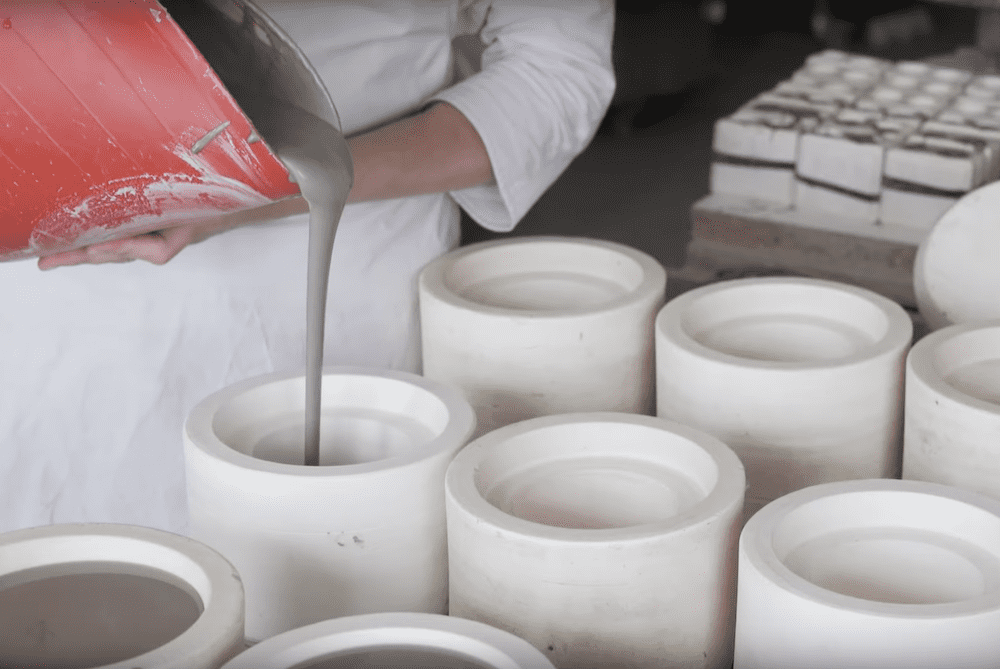
[Image above] Example of slip casting a ceramic mug. A new study found forming method influences the microstructure of flash-sintered ceramics. Credit: Craft Festival, YouTube
While certain applications of ceramics benefit from use at higher temperatures, lower temperatures are the key to energy savings when it comes to processing ceramics.
Flash sintering is a newer ceramic processing technique that allows for lower temperatures. In this process, an electric field is applied to the ceramic during sintering. This combination of heat and electric field causes an abrupt increase in the current flowing through the material, and the thermal effect of the current allows the ceramic to fully densify in a few seconds. (Details of the underlying mechanisms in flash sintering are the subject of ongoing research.)
The low furnace temperatures and short processing time required for flash sintering are the most widely recognized benefits of this process. However, there is also one widely recognized drawback—microstructural heterogeneity of the final ceramic, which can negatively impact its mechanical, chemical, and thermal behaviors.
This heterogeneity primarily originates from different thermal gradients that develop throughout the material during the flash sintering process. These gradients lead to different grain growth between regions, resulting in grain size differences.
Studies showed microstructural heterogeneity may be influenced by the ceramic’s geometry, which makes certain areas more susceptible to becoming hotspots during the flash sintering process. Because geometry is determined in part by the forming method used to fabricate a material, does forming method perhaps influence the final microstructure of a flash-sintered ceramic?
Researchers from the University of São Paulo and Federal University of São Carlos in Brazil investigated this hypothesis in their recent paper. They evaluated the influence of three different forming methods—uniaxial and isostatic pressings and slip casting—on the densification and microstructure of cylindrical flash sintered 3 mol% yttria-stabilized zirconia (3YSZ) ceramics.
They chose these three methods based on the known differences in geometry of materials formed by each method. In uniaxial and isostatic pressing, methods that are based on mechanical pressure, strain gradients can form throughout the material. For uniaxial pressing, these gradients are observed among the powder particles and between powder particles and the die walls, while for isostatic pressing, a strain gradient is observed only among the powder particles. Slip casting, which does not require mechanical pressure, results in a material with a fairly uniform density gradient.
After obtaining samples from each forming method, the researchers sintered the green ceramics using either flash sintering or conventional sintering for comparison.
Analysis of the green and final samples revealed that irrespective of forming method used, all conventionally and flash-sintered ceramics presented high final densities, though densities of conventionally sintered ceramics were slightly higher.
However, there were significant differences in the microstructures of the flash-sintered ceramics formed by each method. Samples prepared by uniaxial pressing had higher microstructure heterogeneity, while isostatically pressed specimens showed better homogeneity than the uniaxially pressed ones. Overall, though, the slip-casted ceramics presented the best microstructure homogeneity for the flash-sintered samples, and they had average grain size similar to the conventionally sintered samples (which presented microstructure homogeneity regardless of forming method).
“Thus, we concluded that the green density gradient (heterogeneous powder packing) produced by the different forming methods play a significant role in the current passage during flash sintering, which can influence the heat dissipation within the specimen,” the researchers conclude.
The paper, published in Materialia, is “Influence of forming methods on the microstructure of 3YSZ flash-sintered ceramics” (DOI: 10.1016/j.mtla.2022.101419).
